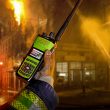It’s a miracle
Like many in his position, Polk County radio communications manager Ben Holycross has faced sometimes skeptical elected officials when asking for budget money to fund the county’s 800 MHz public-safety system that dwarfed the cost of using a commercial cellular operator.
But after the eight-site Motorola Smartzone trunked network managed to stay operational as the eye of three hurricanes — Charley, Frances and Jeanne — traversed through the county over a six week-week period (see map), no one is questioning the investment today, Holycross said.
“No question, it’s expensive, but they’re believers now,” he said.
That belief is rooted in the fact that Polk County’s public-safety-grade system was bolstered with bi-directional microwave loops, supplied by Microwave Networks, and an extensive backup power system that kept the network online as commercial wireline and wireless alternatives died when the area lost power, Holycross said.
“We never lost the microwave connection, so we never lost the radio system,” Holycross said. “Thank God, because nothing else was working.”
Indeed, the fiber-based wireline networks of Sprint and BellSouth in the affected areas failed after the batteries used to provide backup power to the systems were drained in the aftermath of the power outages. And that proved to be problematic for many wireless carriers such as Nextel, which depends on landline T-1 and T-3 connectivity to backhaul its signals.
With all commercial-based forms of voice communications down, the public-safety land mobile radio (LMR) systems provided the only way for rescue workers and recovery crews to coordinate their efforts.
“Private industry is in no way ready to handle the needs of public safety in situations like this,” said Paul Winter, radio communications manager in Charlotte County, where Hurricane Charley first hit. “If we would have relied on them, we would have had a catastrophic loss of life and infrastructure because we would have had nothing [with which to communicate].”
Like the networks supervised by Holycross and Winter, public-safety-grade radio systems throughout Florida held up well throughout the storms during the six-week period, according to Randy Pierce, state communications engineer. Although the winds in excess of 140 mph turned some dish antennas askew and traffic overload created predictable problems in the aftermath of each hurricane, the public-safety-grade networks from vendors such as Motorola, M/A-COM and EFJohnson generally remained online, he said.
But it wasn’t always smooth. Winter said Charlotte County lost a 23-foot antenna to Hurricane Charley, but the damage caused by the storm ironically resolved most of the system’s coverage issues.
“That antenna was designed to provide in-building, high-density coverage,” Winter said. “With the rooftops taken off and the foliage removed from the trees, the propagation from our north site was plenty to provide coverage.”
Holycross said one of Polk County’s spread-spectrum antennas was twisted by the winds — pointing the antenna directly at the county’s recovery operations center, which proved beneficial when a spread-spectrum radio was deployed at the site.
“We were fortunate there,” Holycross said.
Certainly both counties deserved such breaks because they did not get any from Mother Nature. Winter said Charlotte County was preparing to deploy personnel and equipment to other areas of the state when officials learned they would be the first victims of Charley.
“Charlotte wasn’t supposed to be Ground Zero, and Charley wasn’t supposed to be Category 4,” Winter said. “We had less than an hour-and-a-half notice.”
Charley moved through Charlotte County quickly but left a devastating toll, Winter said. Many of the large trees in the community fell, snapping utility poles and power lines during their descent. Within hours, commercial wireline and wireless communications were rendered useless, he said.
Holycross described a similar situation in nearby Polk County, and soon the 800 MHz system was trying to process more than double the amount of push-to-talk communications as the network normally processes, as first responders reacted to the first hurricane to hit the county in 44 years.
“People were trying to be brief … but there was a lot to be said,” Holycross said. “The fact that the system didn’t lock up was a miracle.”
Winter faced this challenge as well, but he encountered a bigger problem during the first weekend after Charley hit. Although the Charlotte County network was operational, an unusual number of calls on the system were being blocked by interference from mobile antennas and repeaters deployed by aid crews from disparate counties.
Pierce eventually called the regional FCC office to resolve the problem, which was caused when the traveling aid crews failed to adhere to Charlotte County’s mutual-aid communications plan.
“After Charley, everyone came in bringing their own toys … and didn’t show much discipline,” Pierce said. “If you don’t want to become a burden and, in fact, want to be an asset, you need to adhere to the communications plan. If there’s a plan, find the plan, institute the plan and make sure everyone’s working the plan.”
Winter added that a hierarchy system is good in concept but often is forgotten in the heat of the moment by well-meaning emergency crews traveling from other counties, who often are deployed to the scene of an incident without communications specialists.
“Communications is the first thing to be blamed after actions, but it’s the last thing people think about at the time,” he said. “Coordinating communications gets missed by first responders in their adrenaline rush to help.”
Winter also noted the need for first responders to receive more training on how to use their radios in mutual-aid situations. In addition, a public-safety-grade data network could enhance efficiencies and offload some of the burden placed on the LMR voice network.
“If you could have put out an e-mail, you could have laid out a communications plan all at once,” Winter said.
Of course, public-safety officials typically handle administrative matters in large-scale emergencies via cell phones so LMR networks can be used to communicate with frontline first responders. But that wasn’t an option in much of the state because the network of the most popular carrier for most governmental agencies in the state — Nextel — was not accessible in most of the affected areas.
Pierce said Nextel’s service typically was down between three to eight days after each of the hurricanes, meaning the carrier was of little use to those trying to deal with the aftermath of the storms.
“I’m sure Nextel will lose a lot of market share in the state of Florida because the service failed so miserably,” Pierce said, noting that limited satellite phones provided the only way to connect to the world outside the range of an LMR system. “But, if you’re a public-safety entity and you depend on that, it’s as much your fault as it is Nextel’s.”
Commercial wireless carriers that fared better in the emergency situation were Alltel and especially Verizon Wireless, which Winter said had restored its network relatively soon after Charley landed and provided hundreds of phones to citizens in shelters trying to reach friends and relatives.
“Yes, it was frustrating — you had dropped calls because the system would get overloaded — but you could do it,” Winter said.
Once again, the key was microwave connectivity — something Verizon and Alltel had from their original cellular infrastructure that is not part of Nextel’s network, which relies on T-1 and T-3 lines to backhaul signals, Winter said. Building the kind of redundancy needed for public-safety-grade systems is not profitable for day-to-day operations in commercial ventures, he added.
“There’s a definite difference between the systems designed for profit and those designed for public safety,” Winter said.
Holycross said he is hopeful it’s a lesson that will be remembered for a long time.
“By Day 1 of the second week after Charley, we were already hearing, ‘Well, I guess it will be another 40 years until we have a hurricane like that,’ then Frances started walking our way,” Holycross said. “In the period right after Frances, there were still a few people saying the same thing when we heard about Ivan.”
Hurricane Ivan veered to the west and missed Polk County, but Hurricane Jeanne didn’t two weeks later.
“After Jeanne hit, I think if you opened your mouth and said it might be another 40 years before a hurricane hits, you might have been punched out,” Holycross said.
But Winter fears even this message will fade over time. As non-public-safety personnel — city administrators, public works officials and park and recreation departments — continue migrating to Nextel and other cellular carriers to take advantage of commercial systems’ smaller devices and increased functionality, the price of LMR systems will increase as market size decreases. And, in an emergency, a government entity’s non-public-safety personnel frequently become first responders in need of reliable communications, Winter said.
“The problem I have is these companies selling themselves to our elected officials, telling them that we shouldn’t be spending so much on our radio systems when we can use theirs for a lot less money,” he said. “But what is that elected official going to tell these families of people whose lives are lost — ‘I saved a few bucks on the communications system?’”
Nextel spokeswoman Leigh Horner said the wireless carrier’s service generally is useful to public safety for offloading traffic from a primary radio network but should not be considered a replacement to an LMR system.
“We absolutely do not sell [Nextel] as a primary system,” Horner said. “It is a supplemental system, and we do not market ourselves as a primary land mobile radio system.”
But Winter said that line between primary and supplemental radio systems are becoming increasingly fuzzy to elected officials, who are attracted by the much lower prices of commercial systems.
“My fear is that these industries are going to say they’ve learned their lessons and rebuilt their systems to handle storms,” Winter said. “People tend to forget. If we lose these battles, the next time, the results could be disastrous.”
HELP WANTED? YOU GOT IT
By Donny Jackson
There may have been communications glitches in Florida as citizens tried to recover from four hurricanes that hit the state in a six-week timeframe, but one thing that wasn’t lacking was a willingness to help — a source of appreciation and marvel for all involved in the process.
“Equipment was not an issue,” said Ben Holycross of Polk County, which provided its mobile wireless tower to other areas of the state. “If someone else needed parts and someone had them, they were made available as soon as possible.”
Indeed, state communications engineer Randy Pierce said he eventually had to tell officials “to turn the [aid] valve off” in some cases because the flood of donations had become more of an administrative burden than a benefit to the hurricane victims.
And the donation of equipment paled in comparison to the valuable time and effort given by personnel in and around the impacted regions.
Matt Stillwell, president of the Florida chapter of the Association of Public-Safety Communications Officers (APCO), said volunteer dispatchers frequently worked 12 to 14 hours per day without being able to tend to their own issues and with little hope of relief because manpower was being stretched thin throughout the state.
One dispatcher who worked tirelessly in Charlotte County had just bought a house in the area — only to have it destroyed by Hurricane Charley three days after closing, Stillwell said.
“Not only did they have professional problems, but they also had personal problems — many had their homes destroyed,” Stillwell said. “A lot of them, for a couple of weeks, didn’t have a chance to take care of themselves because they were so busy helping other people. There you are solving everybody else’s problems, and no one is helping you with your problems. That has to be a big stress.”
And the stress was not just limited to those in the public-safety realm. At least one shipping company maintained operations in the aftermath of storms in an effort to deliver items to hurricane victims, despite the fact that high winds had blown the roof off its building.
Perhaps the most difficult aspect of the hurricanes was their timing. Dealing with even a single hurricane is always a challenge, but the sequence of one hurricane after another meant the providers of aid one week often were requesting help the following week. The entire episode left citizens in all walks of life throughout Florida mentally and physically drained.
“I think the surprise for everybody is that four storms hit in six weeks-that puts everything to a test,” Nextel spokeswoman Michele Pinnau said. “We hope it never happens again.”
The Florida APCO chapter has established a relief fund for dispatchers affected by the storms. For more information, visit organization’s Web site: www.apco-florida.org.

















